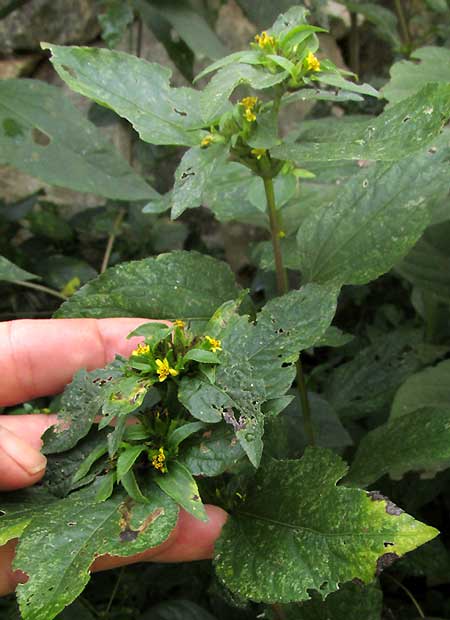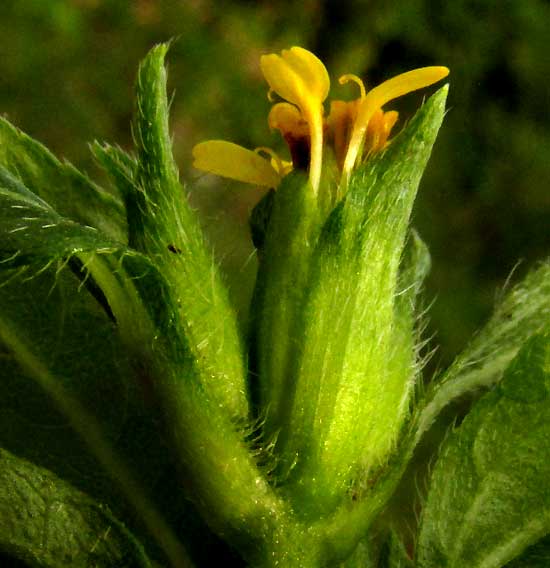Excerpts from Jim Conrad's
Naturalist Newsletter
from the February 15, 2019 Newsletter issued from Rancho Regensis north of Valladolid, Yucatán, MÉXICO;
elevation ~40m (~130 ft), N~20.876°, W~88.170°
SYNEDRELLA BY THE WALL
On the north side of the stone wall beside the garden, thus in the shade, a foot-tall, bug-eaten weed bore cluttered clusters of yellow flowers so small they were hardly noticeable, shown below:

Up close, the flowers proved to be of the composite type, with petal-like ray flowers surrounding an "eye' of crammed-together, cylindrical disc flowers, thus a member of the huge Composite/Aster/Sunflower Family, the Asteraceae. But this plant's composite heads were so irregularly composed, with such short ray flowers and so few disc flowers, that at first glance it was hard to recognize the structure, as seen below:

However, below, a side view of a composite head shows the head subtended by green bracts, just as a composite head is supposed to be:

And if any further proof is needed of the plant's membership in the Composite Family, by breaking open an almost-matured head, the one-seeded, cypsela-type fruits show themselves to be topped with sharp, upward-pointing, spiny "awns" similar to those atop such quintessential Composite-Family members as the sticktights, genus Bidens, as shown below:

In that picture you might be able to make out that within the head the fruits are separated from one another by thin, green, scale-like structures, or phyllaries.
All these features and a few more lead us to the name SYNEDRELLA NODIFLORA, whose English name sometimes is given as Synedrella. The name Synedrella is derived from the Greek synedros, meaning "placed together," referring to the crowding of the small flowering heads. Synedrella is native to the American tropics, where it occurs throughout, but as a weed has invaded every tropical country on Earth where its habitat is provided. Sometimes it turns up in Florida, where the online Flora of North America says that it seems to be introduced recurrently, but probably doesn't persist.
You could hardly imagine a more raggedy, humble-looking little weed, but I did see some tiny bugs looking snug and prosperous among the flowers, and I suspect certain finch-type birds able to deal with the fruits' sharp awns will be glad to have the nourishment provided by the seeds.
Also, I read that in Ghana certain communities have used Synedrella medicinally to treat epilepsy. This encouraged research by Patrick Amoateng and others, whose results were published in a 2012 edition of the Journal of Pharmacy & BioAllied Sciences. It was found that extracts from the entire plant "significantly reduced the latencies to myolonic jerks and seizures as well as seizure duration and the percentage severity."
In other words, lab results support the traditional use of the plant for treating epilepsy.